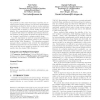100 search results - page 7 / 20 » Predicting protein folds with structural repeats using a cha... |
GECCO
2005
Springer
14 years 1 months ago
2005
Springer
The prediction of the native structures of proteins, the socalled protein folding problem, is a NP hard multi-minima optimization problem for which to date no routine solutions ex...
BMCBI
2007
13 years 7 months ago
2007
Background: Protein motions play an essential role in catalysis and protein-ligand interactions, but are difficult to observe directly. A substantial fraction of protein motions i...
BMCBI
2006
13 years 7 months ago
2006
Background: The structure of proteins may change as a result of the inherent flexibility of some protein regions. We develop and explore probabilistic machine learning methods for...
CCE
2008
13 years 7 months ago
2008
Protein structure determination and prediction has been a focal research subject in life sciences due to the importance of protein structure in understanding the biological and ch...
BMCBI
2008
13 years 7 months ago
2008
Background: We present a novel method of protein fold decoy discrimination using machine learning, more specifically using neural networks. Here, decoy discrimination is represent...

